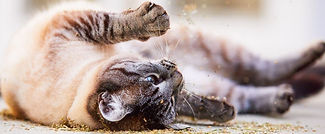Our KickAss Blend contains three different genus of catnip + silvervine!


Photo credit cats.com


Silvervine powder.
We us a variety of organic catnip grown by reputable growers in the USA. We also grow our own fresh catnip in flower containers all year long. The variety of herbs helps assure your cat will enjoy one, or all of the ingredients in our kickers! After our varieties are blended, we add a mix of dry silvervine and silvervine in powder form, made from the fruit.

KickAss Blend is kept airtight, then stored in a cool dark place to keep fresh until your kickers are assembled!




Photo Credit AMC
What Is Catnip?
Catnip (Nepeta cataria) is an herb in the mint family. It is a perennial plant, originally native to Europe, Asia and the Middle East, but now widely cultivated throughout the world. Also known as catswort, catmint, field balm and many other names. Not all cats are sensitive to catnip, but a high percentage of cats, and even large wild cats, have at least some sensitivity to the herb. That sensitivity is genetic, and is triggered by the aroma of the catnip. The herb contains nepetalactone, which mimics the pleasurable pheromones of cats. When cats sniff the herb, the aroma bonds to their smell receptors and can initiate a wide range of behaviors.
What Is Silvervine?
Found in Asia, cats react in a similar way to catnip. While catnip is a herbaceous plant, silvervine is a fruit-bearing vine. It grows in mountainous regions of China, Korea, Japan, and Eastern Russia. Silvervine will produce little white flowers with yellow centers for about a month in the summertime. Then in October, the vine will sprout egg-shaped fruit for a month. Silvervine, has two main chemicals that cats respond to, called actinide and dihydroactinidiolide. It also contains around six other active ingredients similar to the chemical found in catnip.


Photo credit: asahi
